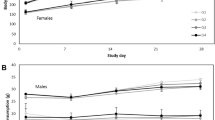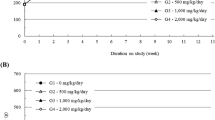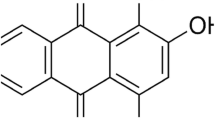Abstract
Echinacea purpurea (L.), a member of Asteraceae family, has traditionally been used in numerous countries to treat and prevent various immune-related diseases. This study confirmed the oral toxicity and genotoxicity profile of standardized E. purpurea extract under good laboratory practice (GLP) conditions and the pharmacokinetic features of chicoric acid, a major ingredient in E. purpurea extract. For the repeated-dose toxicity test, Sprague Dawley (SD) rats were orally administered 500, 1000, and 2000 mg/kg/day of E. purpurea extract continuously for 13 weeks. The genotoxicity of E. purpurea was determined using standard genotoxicity tests, including bacterial reverse mutations, chromosome aberrations, and micronucleus tests. Additionally, a validated LC–MS/MS method was employed to measure chicoric acid levels in rat plasma for pharmacokinetic analysis. The results of this study indicate that during repeated oral administration of E. purpurea, both male and female SD rats showed no abnormal clinical signs. Furthermore, the genotoxicity tests did not reveal any evidence of genotoxicity in E. purpurea. Pharmacokinetic profile of chicoric acid, following the oral administration of highly purified chicoric acid (95%) and standardized E. purpurea extracts containing 2% chicoric acid, revealed the oral bioavailability to be approximately 1.5%. Increasing the dose of standardized E. purpurea extract (equivalent to 20–100 mg/kg of chicoric acid) from 1 to 5 g/kg resulted in a proportional increase in systemic exposure without reaching saturation. In this study, E.purpurea did not cause oral toxicity and genotoxicity. Additionally, the crude formulation was found to have minimal impact on the pharmacokinetics of chicoric acid.




Similar content being viewed by others
Data availability
Data and material that support the findings of the study are available from the corresponding author upon reasonable request.
References
Barrett B (2003) Medicinal properties of Echinacea: a critical review. Phytomedicine 10:66–86. https://doi.org/10.1078/094471103321648692
Singh A, Gautam A, Singh B, Navneet (2022) Antiviral effects of medicinal plants and their active phytochemical constituents against respiratory diseases and associated biological functions. In: Coronavirus drug discovery. Elsevier, pp 23–54. https://doi.org/10.1016/B978-0-323-95574-4.00012-3
Manayi A, Vazirian M, Saeidnia S (2015) Echinacea purpurea: Pharmacology, phytochemistry and analysis methods. Pharmacogn Rev 9:63. https://doi.org/10.4103/0973-7847.156353
Bhattaram VA, Graefe U, Kohlert C, Veit M, Derendorf H (2002) Pharmacokinetics and bioavailability of herbal medicinal products. Phytomedicine 9:1–33. https://doi.org/10.1078/1433-187x-00210
Lee J, Scagel CF (2013) Chicoric acid: chemistry, distribution, and production. Front Chem 1:40. https://doi.org/10.3389/fchem.2013.00040
Peng Y, Sun Q, Park Y (2019) The bioactive effects of chicoric acid as a functional food ingredient. J Med Food 22:645–652. https://doi.org/10.1089/jmf.2018.0211
Pizzorno JE, Murray MT (2020) Textbook of natural medicine-e-book. Elsevier Health Sciences
European Medicines Agency (2013) Assessment report on Echinacea purpurea (L.) Moench., herba recens.
Mekjaruskul C, Jay M, Sripanidkulchai B (2012) Pharmacokinetics, bioavailability, tissue distribution, excretion, and metabolite identification of methoxyflavones in Kaempferia parviflora extract in rats. Drug Metab Dispos 40:2342–2353. https://doi.org/10.1124/dmd.112.047142
Hung WL, Chang WS, Lu WC, Wei GJ, Wang Y, Ho CT, Hwang LS (2018) Pharmacokinetics, bioavailability, tissue distribution and excretion of tangeretin in rat. J Food Drug Anal 26:849–857. https://doi.org/10.1016/j.jfda.2017.08.003
Pourhosseini SH, Mirjalili MH, Ghasemi M, Ahadi H, Esmaeili H, Ghorbanpour M (2020) Diversity of phytochemical components and biological activities in Zataria multiflora Boiss. (Lamiaceae) populations. S Afr J Bot 135:148–157. https://doi.org/10.1016/j.sajb.2020.08.024
Kim HR, Kim YS, Lee DR, Choi BK, Kwon KB, Bae GS (2022) Echinacea purpurea alleviates cyclophosphamide-induced immunosuppression in mice. Appl Sci 12:105. https://doi.org/10.3390/app12010105
Organisation for Economic Cooperation and Development (OECD) (1997) OECD guideline for testing of chemicals: bacterial reverse mutation test No. 471. OECD, Paris
Organisation for Economic Cooperation and Development (OECD) (1997) OECD guideline for testing of chemicals: in vitro mammalian chromosome aberration test No. 473. OECD, Paris
Kim JW, Kim H, Park H, Yoon JS, Kim MI, Ko JW, Kim TW (2022) Repeated oral dose toxicity and genotoxicity of a standardized Quisqualis indica extract. Toxicol Res 38:577–589. https://doi.org/10.1007/s43188-022-00140-6
Organisation for Economic Cooperation and Development (OECD) (1996) OECD guideline for testing of chemicals: mammalian erythrocyte micronucleus test No. 474. OECD, Paris
Ministry of Food and Drug Safety (2023) Guideline on bioanalytical method validation. https://www.mfds.go.kr/brd/m_1060/view.do?seq=15366. Accessed 27 Oct 2023
Toutain PL, Bousquet-mélou A (2004) Plasma clearance. J Vet Pharmacol Ther 27:415–425. https://doi.org/10.1111/j.1365-2885.2004.00605.x
Hohmann J, Rédei D, Forgo P, Szabó P, Freund TF, Haller J, Bojnik E, Benyhe S (2011) Alkamides and a neolignan from Echinacea purpurea roots and the interaction of alkamides with G-protein-coupled cannabinoid receptors. Phytochemistry 72:1848–1853. https://doi.org/10.1016/j.phytochem.2011.06.008
Liu C, Douglas RM (1998) Chinese herbal medicines in the treatment of acute respiratory infections: a review of randomised and controlled clinical trials. Med J Aust 169:579–582. https://doi.org/10.5694/j.1326-5377.1998.tb123423.x
Mengs U, Leuschner J, Marshall RR (2000) Toxicity studies with Echinacin-Third international conference on phytomedicine. Phytomedicine 2(Suppl):32
Dalby-Brown L, Barsett H, Landbo AKR, Meyer AS, Mølgaard P (2005) Synergistic antioxidative effects of alkamides, caffeic acid derivatives, and polysaccharide fractions from Echinacea purpurea on in vitro oxidation of human low-density lipoproteins. J Agri Food Chem 53:9413–9423. https://doi.org/10.1021/jf0502395
Matthias A, Addison RS, Penman KG, Dickinson RG, Bone KM, Lehmann RP (2005) Echinacea alkamide disposition and pharmacokinetics in humans after tablet ingestion. Life Sci 77:2018–2029. https://doi.org/10.1016/j.lfs.2005.04.009
Dall’Acqua S, Perissutti B, Grabnar I, Farra R, Comar M, Agostinis C, Caristi G, Golob S, Voinovich D (2015) Pharmacokinetics and immunomodulatory effect of lipophilic Echinacea extract formulated in softgel capsules. Eur J Pharm Biopharm 97:8–14. https://doi.org/10.1016/j.ejpb.2015.09.021
Gan C, Liu L, Du Y, Wang L, Gao M, Wu L, Yang C (2016) Simultaneous determination and pharmacokinetic study of four phenol compounds in rat plasma by ultra-high performance liquid chromatography with tandem mass spectrometry after oral administration of Echinacea purpurea extract. J Sep Sci 39:1628–1637. https://doi.org/10.1002/jssc.201600051
Wang Y, Xie G, Liu Q, Duan X, Liu Z, Liu X (2016) Pharmacokinetics, tissue distribution, and plasma protein binding study of chicoric acid by HPLC–MS/MS. J Chromatogr B Analyt Technol Biomed Life Sci 1031:139–145. https://doi.org/10.1016/j.jchromb.2016.07.045
Du Y, Wang Z, Wang L, Gao M, Wang L, Gan C, Yang C (2017) Simultaneous determination of seven phenolic acids in rat plasma using UHPLC–ESI–MS/MS after oral administration of Echinacea purpurea extract. Molecules 22:1494. https://doi.org/10.3390/molecules22091494
Wang GN, Wang JP, Zhang H, Miao YT, Bai Y, Liu JX (2021) Determination of chicoric acid content in plasma and urine of rats by ultra-performance liquid chromatography and related pharmacokinetic study. Chin J Vet Med 57:97–101
Li X (2011) Oral bioavailability: basic principles, advanced concepts, and applications. John Wiley & Sons. https://doi.org/10.1002/9781118067598
Wang GN, Li YP, Yuan SK, Zhang H, Ren J, Ren X, Liu JX (2022) The intestinal absorption mechanism of chicoric acid and its bioavailability improvement with chitosan. Heliyon 8:e09955. https://doi.org/10.1016/j.heliyon.2022.e09955
Kelder J, Grootenhuis PD, Bayada DM, Delbressine LP, Ploemen JP (1999) Polar molecular surface as a dominating determinant for oral absorption and brain penetration of drugs. Pharm Res 16:1514–1519. https://doi.org/10.1023/a:1015040217741
Menard S, Cerf-Bensussan N, Heyman M (2010) Multiple facets of intestinal permeability and epithelial handling of dietary antigens. Mucosal Immunol 3:247–259. https://doi.org/10.1038/mi.2010.5
National Center for Biotechnology Information (2023) PubChem compound summary for CID 5281764, Chicoric acid. PubChem. https://pubchem.ncbi.nlm.nih.gov/compound/Chicoric-acid
Kushida H, Matsumoto T, Ikarashi Y (2021) Properties, pharmacology, and pharmacokinetics of active indole and oxindole alkaloids in uncaria hook. Front Pharmacol 12:688670. https://doi.org/10.3389/fphar.2021.688670
Gai Y, Chen H, Liu W, Feng F, Xie N (2014) The metabolism of YiGan San and subsequent pharmacokinetic evaluation of four metabolites in rat based on liquid chromatography with tandem mass spectrometry. J Chromatogr B Analyt Technol Biomed Life Sci 972:22–28. https://doi.org/10.1016/j.jchromb.2014.09.033
Chen L, Ma J, Wang X, Zhang M (2020) Simultaneous determination of six uncaria alkaloids in mouse blood by UPLC–MS/MS and its application in pharmacokinetics and bioavailability. Biomed Res Int 2020:1030269. https://doi.org/10.1155/2020/1030269
Zhang A, Sun H, Wang X, Jiao G, Yuan Y, Sun W (2012) Simultaneous in vivo RP-HPLC-DAD quantification of multiple-component and drug–drug interaction by pharmacokinetics, using 6, 7-dimethylesculetin, geniposide and rhein as examples. Biomed Chromatogr 26:844–850. https://doi.org/10.1002/bmc.1739
Guo Z, Li B, Gu J, Zhu P, Su F, Bai R, Liang X, Xie Y (2019) Simultaneous quantification and pharmacokinetic study of nine bioactive components of orthosiphon stamineus Benth. Extract in rat plasma by UHPLC-MS/MS. Molecules 24:3057. https://doi.org/10.3390/molecules24173057
Sun X, Zhang X, Zhai H, Zhang D, Ma S (2019) Chicoric acid (CA) induces autophagy in gastric cancer through promoting endoplasmic reticulum (ER) stress regulated by AMPK. Biomed Pharmacother 118:109144. https://doi.org/10.1016/j.biopha.2019.109144
Tsai YL, Chiu CC, Chen JYF, Chan KC, Lin SD (2012) Cytotoxic effects of Echinacea purpurea flower extracts and cichoric acid on human colon cancer cells through induction of apoptosis. J Ethnopharmacol 143:914–919. https://doi.org/10.1016/j.jep.2012.08.032
Xiao H, Wang J, Yuan L, Xiao C, Wang Y, Liu X (2013) Chicoric acid induces apoptosis in 3T3-L1 preadipocytes through ROS-mediated PI3K/Akt and MAPK ignalling pathways. J Agric Food Chem 61:1509–1520. https://doi.org/10.1021/jf3050268
Funding
No external funding was used.
Author information
Authors and Affiliations
Contributions
TWK and JWK (Je-Won Ko) designed the experiments. JSJ, JWK (Jeong-Won Kim), JHK, EHC, DRL, and BKC collected and analyzed the data. All authors read and approved the final manuscript.
Corresponding authors
Ethics declarations
Conflict of interest
The authors declare that they have no competing interests.
Supplementary Information
Below is the link to the electronic supplementary material.
Rights and permissions
Springer Nature or its licensor (e.g. a society or other partner) holds exclusive rights to this article under a publishing agreement with the author(s) or other rightsholder(s); author self-archiving of the accepted manuscript version of this article is solely governed by the terms of such publishing agreement and applicable law.
About this article
Cite this article
Jeong, JS., Kim, JW., Kim, JH. et al. Oral toxicity and genotoxicity assessment of standardized Echinacea purpurea (L.) extract and the pharmacokinetic profile of its active ingredient chicoric acid. Toxicol Res. (2024). https://doi.org/10.1007/s43188-024-00238-z
Received:
Revised:
Accepted:
Published:
DOI: https://doi.org/10.1007/s43188-024-00238-z




